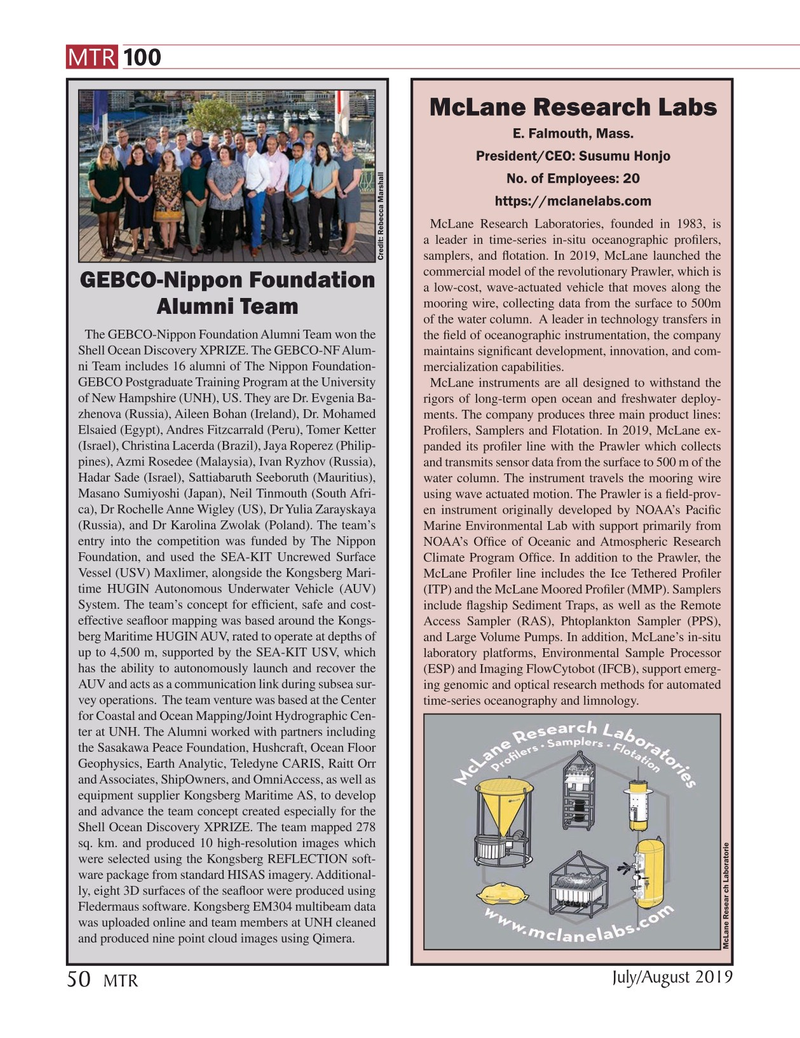
Page 50: of Marine Technology Magazine (July 2019)
MTR White Papers: Hydrographic
Read this page in Pdf, Flash or Html5 edition of July 2019 Marine Technology Magazine
MTR 100
McLane Research Labs
E. Falmouth, Mass.
President/CEO: Susumu Honjo
No. of Employees: 20 https://mclanelabs.com
McLane Research Laboratories, founded in 1983, is a leader in time-series in-situ oceanographic pro? lers, samplers, and ? otation. In 2019, McLane launched the
Credit: Rebecca Marshall commercial model of the revolutionary Prawler, which is
GEBCO-Nippon Foundation a low-cost, wave-actuated vehicle that moves along the mooring wire, collecting data from the surface to 500m
Alumni Team of the water column. A leader in technology transfers in
The GEBCO-Nippon Foundation Alumni Team won the the ? eld of oceanographic instrumentation, the company
Shell Ocean Discovery XPRIZE. The GEBCO-NF Alum- maintains signi? cant development, innovation, and com- ni Team includes 16 alumni of The Nippon Foundation- mercialization capabilities.
GEBCO Postgraduate Training Program at the University McLane instruments are all designed to withstand the of New Hampshire (UNH), US. They are Dr. Evgenia Ba- rigors of long-term open ocean and freshwater deploy- zhenova (Russia), Aileen Bohan (Ireland), Dr. Mohamed ments. The company produces three main product lines:
Elsaied (Egypt), Andres Fitzcarrald (Peru), Tomer Ketter Pro? lers, Samplers and Flotation. In 2019, McLane ex- (Israel), Christina Lacerda (Brazil), Jaya Roperez (Philip- panded its pro? ler line with the Prawler which collects pines), Azmi Rosedee (Malaysia), Ivan Ryzhov (Russia), and transmits sensor data from the surface to 500 m of the
Hadar Sade (Israel), Sattiabaruth Seeboruth (Mauritius), water column. The instrument travels the mooring wire
Masano Sumiyoshi (Japan), Neil Tinmouth (South Afri- using wave actuated motion. The Prawler is a ? eld-prov- ca), Dr Rochelle Anne Wigley (US), Dr Yulia Zarayskaya en instrument originally developed by NOAA’s Paci? c (Russia), and Dr Karolina Zwolak (Poland). The team’s Marine Environmental Lab with support primarily from entry into the competition was funded by The Nippon NOAA’s Of? ce of Oceanic and Atmospheric Research
Foundation, and used the SEA-KIT Uncrewed Surface Climate Program Of? ce. In addition to the Prawler, the
Vessel (USV) Maxlimer, alongside the Kongsberg Mari- McLane Pro? ler line includes the Ice Tethered Pro? ler time HUGIN Autonomous Underwater Vehicle (AUV) (ITP) and the McLane Moored Pro? ler (MMP). Samplers
System. The team’s concept for ef? cient, safe and cost- include ? agship Sediment Traps, as well as the Remote effective sea? oor mapping was based around the Kongs- Access Sampler (RAS), Phtoplankton Sampler (PPS), berg Maritime HUGIN AUV, rated to operate at depths of and Large Volume Pumps. In addition, McLane’s in-situ up to 4,500 m, supported by the SEA-KIT USV, which laboratory platforms, Environmental Sample Processor has the ability to autonomously launch and recover the (ESP) and Imaging FlowCytobot (IFCB), support emerg-
AUV and acts as a communication link during subsea sur- ing genomic and optical research methods for automated vey operations. The team venture was based at the Center time-series oceanography and limnology. for Coastal and Ocean Mapping/Joint Hydrographic Cen- ter at UNH. The Alumni worked with partners including the Sasakawa Peace Foundation, Hushcraft, Ocean Floor
Geophysics, Earth Analytic, Teledyne CARIS, Raitt Orr and Associates, ShipOwners, and OmniAccess, as well as equipment supplier Kongsberg Maritime AS, to develop and advance the team concept created especially for the
Shell Ocean Discovery XPRIZE. The team mapped 278 sq. km. and produced 10 high-resolution images which were selected using the Kongsberg REFLECTION soft- ware package from standard HISAS imagery. Additional- ly, eight 3D surfaces of the sea? oor were produced using
Fledermaus software. Kongsberg EM304 multibeam data was uploaded online and team members at UNH cleaned and produced nine point cloud images using Qimera.
McLane Resear ch Laboratorie
July/August 2019 50
MTR
MTR #6 (50-65).indd 50 7/31/2019 11:54:25 AM

 49
49

 51
51
